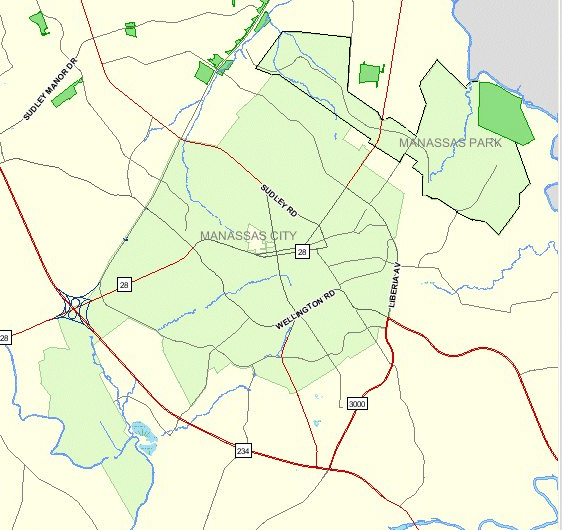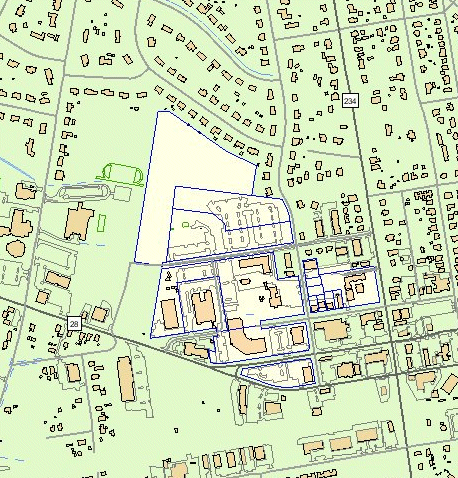
boundaries of cities - Manassas and Manassas Park
Source: Prince William County Mapper
Civic government in Virginia is based on the state's constitution, and the key direction in Northern Virginia political's geography is "start at the top, and work down."
The first state constitution was adopted at the start of the American Revolution, at the Fifth Revolutionary Convention in 1776. The first version was written and adopted over a decade before the Federal Constitution. New state constitutions were adopted in 1850, 1869, and 1902. The last major revision of the state constitution was implemented in 1971, but voters approve changes every few years.
The 1776 constitution established that Virginia was no longer a colony of Great Britain. It also centralized all political power in the state government, as the representative of the people. In Virginia, political authority flows from the people to the General Assembly, and only then to the towns, counties, and cities. Local governments exist only as subdivisions of the state, not through any independent compact with "the people."
In Virginia, the power of "we the people" has never been aggregated *up* from the people directly to local governments. Authority loops through the state government first. The strict interpretation of state primacy, the Dillon Rule, means elected officials in counties/towns/cities have only the authorities specifically granted to them by the General Assembly.
Cities own and maintain their roads, while Virginia counties (except for Arlington and Henrico) rely upon VDOT for road maintenance. Cities get a fixed allocation of state funding for building and maintaining those roads, while counties must compete with each other and other VDOT priorities for a substantial portion of their road budget. Cities have been granted more authorities, such as the right of city councils to issue bonds to build roads without a voter referendum (counties must get voter approval in a referendum before issuing road bonds).
In Virginia, towns have distinct boundaries, established by the General Assembly or by courts guided by laws passed by the legislature. Towns are *not* independent from counties; residents of towns are still residents of the county in which the town is located. For example, residents of the four towns of Haymarket, Quantico, Dumfries, and Occoquan are also residents of Prince William County. They pay both town and county property taxes, and town residents get to vote for a town council/mayor.
Why bother? At one time, town residents paid for town constables, to ensure someone with police authority would be available in the more-developed area even when sheriff deputies had to roam widely across a county. Today, towns have authority for land use decisions, and town officials can work directly with developers to shape the changes within town boundaries.
Prince William officials do not have any authority over planning, zoning, or site plan approvals in the four towns. Haymarket has been redeveloping its town center without having to get any blessings from Prince William County, and all proffers from developers for parcels within the town boundary have been negotiated by Haymarket officials.
However, the General Assembly may become quite specific in the charter it grants to a "municipal corporation." Curiously, the town charter from the General Assembly even gives Haymarket some control over development in Prince William County within one mile of the border of the town:
(The town of Purcellville reached an agreement with Loudoun County that required town approval for building Woodgrove High School at Fields Farm near the town's border. Whether or not to grant approval was the key issue in the mayoral election in 2004 and 2008.)
The cities of Manassas and Manassas Park are completely independent jurisdictions, separate from the county. City residents pay city taxes and elect city officials, and have no say in county affairs. Cities run their own school systems, maintain city streets, and of course make land use decisions for parcels with the city.
Read:

Prince William County and the City of Manassas had to go to court a decade ago to resolve who had authority to authorize expansion of the jail in downtown Manassas. Turns out there is a "hole in the doughnut" when it comes to land ownership. Manassas incoporated as a city in 1975, shifting from town status. After incorporation, the county courthouse complex was not included within the city boundaries. The city surrounds the courthouse parcels on all sides, but the county has authority to approve land use changes on those courthouse parcels.
The General Assembly creates counties, towns, and cities by issuing specific charters to municipal corporations, or defining procedures for communities to incorporate. Boundaries of counties/cities/towns are defined by the General Assembly, in some cases many years ago - or by recent annexations approved by state courts.
Towns and cities can expand their boundaries by "annexing" territory of counties. Annexation made sense when counties offered few services to rural residents making a living by farming, while town/city residents needed urban services such as water/sewer, upgraded fire and police protection, etc. Just like Dumfries, Alexandria was originally chartered for a 60-acre site. George Washington assisted in the survey to subdivide those Alexandria acres into eighty-four lots with ten streets. Alexandria grew by adding (annexing) property that used to be in Arlington or Fairfax counties.
In modern NOVA, where counties offer full urban services except in a few designated rural areas, the distinction between town/city/county is getting outdated. Even Northern Virginians value tradition, so I don't predict any major reorganization of government authority. We might see increased regionalization of services such as water, sewer, and perhaps transit.
Where there is an economy of scale in building a larger facility (i.e., building one large regional jail is more cost effective than building separate jails for each jurisdiction) - look for regional cooperation to grow. Where there are few advantages associated with regional sharing, such as building neighborhood schools - look for local jurisdictions to stay independent from each other.
Perhaps Northern Virginia will always have towns, but perhaps not. Instead of creating new towns and splitting responsibility further from county officials, the political geography may shift towards consolidating governments - even regionalization. We saw in the recent state Supreme Court decision on the Northern Virginia Transportation Authority (NVTA) that the legislature could also charter regional governments authorized to raise taxes, so long as the regional governments were elected by the people rather than appointed.